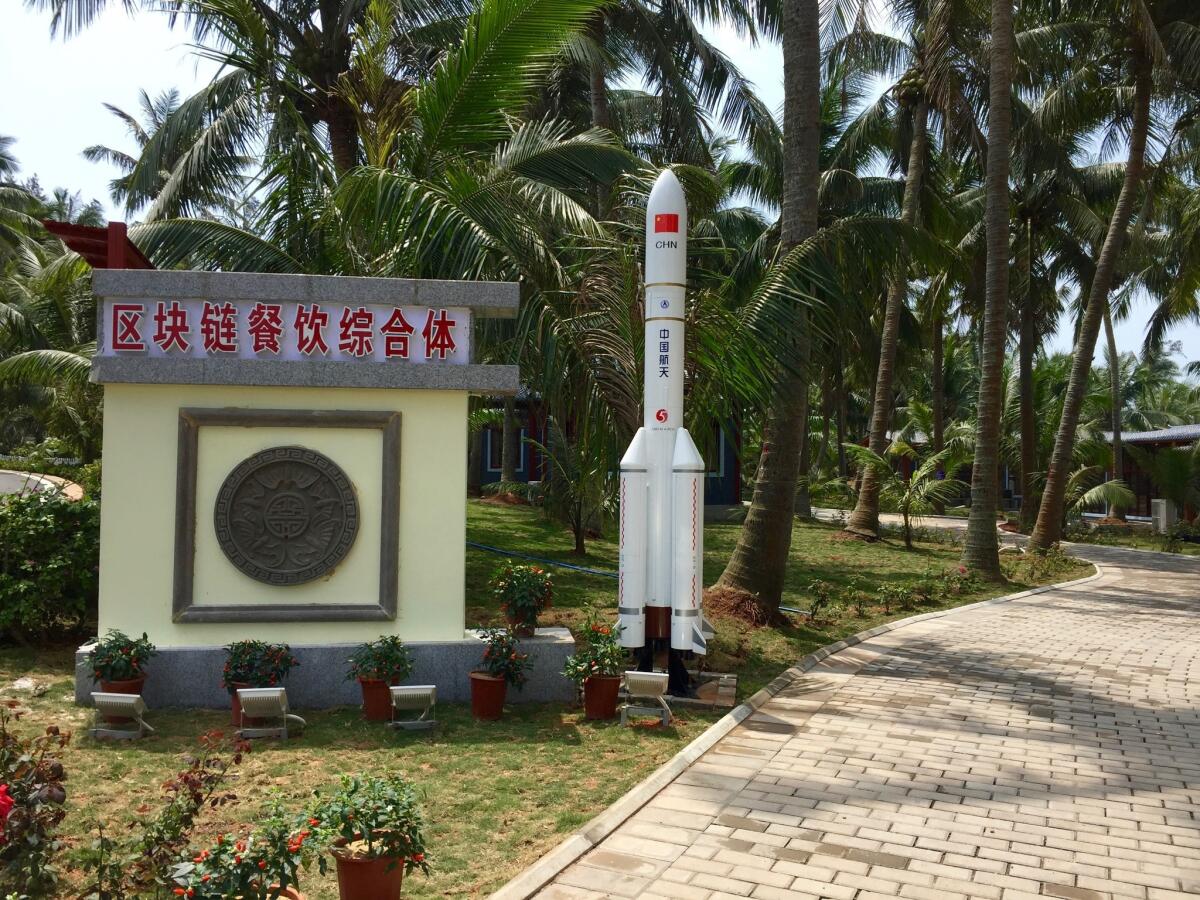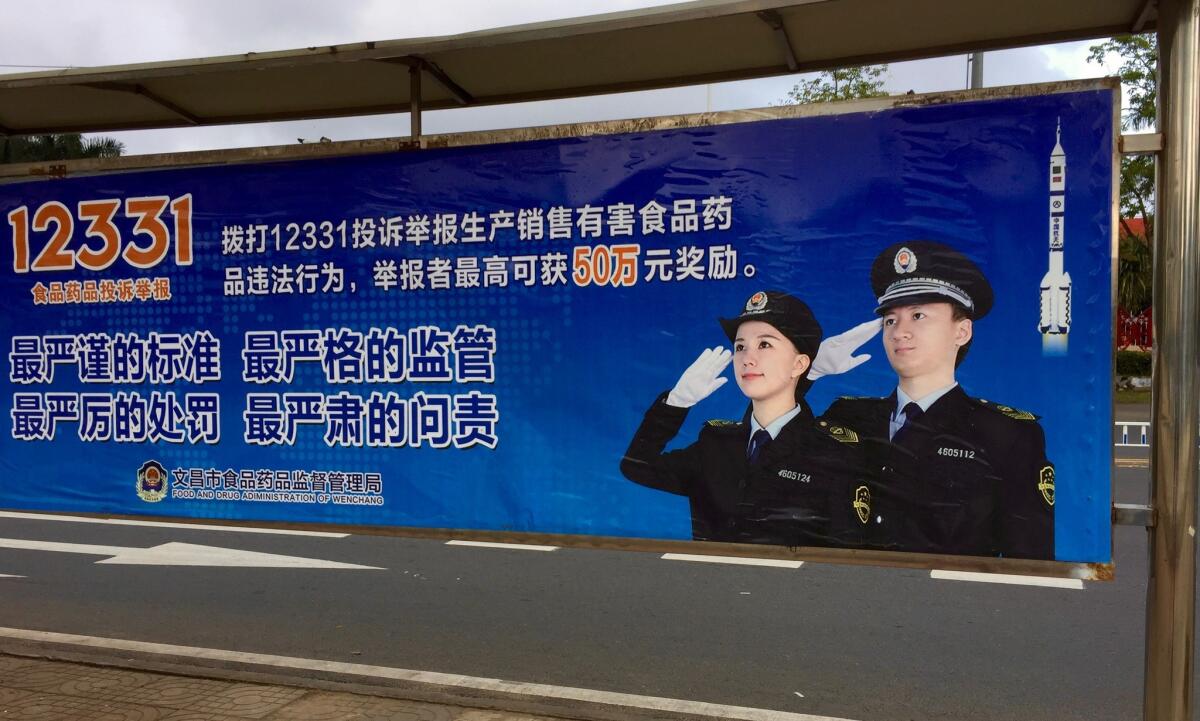Aerospace peppers and astronaut robots: A town’s transformation reveals China’s ambitions in space

China is investing millions in space exploration. (May 11, 2017) (Sign up for our free video newsletter here)
If you follow China’s bold ambition to join the great space powers, it will eventually lead you here, to the neglected eastern edge of steamy Hainan island, in a speck of a village that doesn’t appear on most maps.
Rocket replicas and signs for Wi-Fi welcome visitors past coconut trees and peppers grown from seeds bred in space. Guide maps show what this hamlet of about 50 residents might become, though the blacktop still looks fresh and most of the noise comes from the chicken coop. A robot in astronaut attire zips around an empty restaurant.
Local officials envision Haosheng as the start of a thriving tourist destination tied to nearby Wenchang Satellite Launch Center, much in the way Florida’s Space Coast draws visitors interested in Cape Canaveral. China’s newest spaceport opened for tours last year and just sent the country’s first cargo spacecraft into orbit.

Chinese officials have realized — much as the U.S. did in the 1960s — that a popular space program can serve as a rallying point for national pride, a notion key to President Xi Jinping’s quest for “national rejuvenation.” The latest efforts help recast a clandestine military-led program into an entertaining, tourist-friendly initiative as China demonstrates its ascent and tests U.S. supremacy in space.
“Space exploration is a standard mark of whether the country is developed,” said Wumei Ling, 23, who assists at the visitors center, a shed filled with pamphlets of cuddly alien mascots.
“The distance between the U.S. and China is shortening. I’m very proud.”
China still lags far behind the U.S. but is investing millions amid uncertainty about Washington’s priorities. It’s also vying against ambitious private companies like Hawthorne-based SpaceX that assist NASA and seek to dominate frontier markets.
Xi has tethered space power to the country’s rise. Last year for the first time, China launched more rockets than Russia. The nation also undertook its longest crewed mission and completed the world’s largest radio telescope. It aims to land a rover on the far side of the moon next year, a first for any country, and put a probe on Mars by 2020.
“Just 10 or 20 years ago, you could not imagine China doing what it’s done or plans to do,” said Zong Qiugang, an astrophysicist at Peking University in Beijing, who has worked with the U.S and Chinese space agencies.
South of Haosheng, launch towers jut into the horizon. The government embedded the three other spaceports deep in the interior. That makes this one — located a half-hour drive from the coastal city of Wenchang in China’s southernmost province — the most accessible.
Hundreds of people climbed on top of buildings and lined up along the beach late last month to watch the cargo spacecraft shoot into the atmosphere. Even more gathered in June for the center’s first launch, the test flight of a liquid-fueled carrier rocket.
“It’s a major shift from a program that was owned by the military and covered in secrecy to one that is more open to the rest of Chinese society and looking towards the outside,” said Gregory Kulacki, China project manager for the Union of Concerned Scientists, a nonprofit science advocacy organization.

When the U.S. put a man on the moon in 1969, China was busy condemning “capitalist devils” and closing colleges as part of the Cultural Revolution. The nation put its first astronaut in space more than three decades later.
The latest launch puts China a step closer to the orbiting space station it plans to complete by 2022, around the time the International Space Station — which is largely operated by the U.S. and bans the communist country — winds down. This would make China the only nation with a permanent presence in space.
But the days of a Sputnik-style race have ended. China’s space goals are as much about cultural prestige, diplomacy and economics as they are about geopolitical tactics.
Efforts like Haosheng underscore that strategy.
“It would be a pity not to play the ‘aerospace card,’” Wenchang Mayor Wang Xiaoqiao told state media in January when he announced Haosheng’s transformation. He described a region prosperous from tech advancements and aerospace training.
The village only recently opened as a space tourism destination, and Ou Rongdong, who is starting an open-air restaurant topped with fake ivy, serves as its de facto greeter.
The jovial 39-year-old, clad in jeans and a T-shirt, calls himself an “honorary citizen,” because he’s from the mainland. Ou detailed the new plans as he lunched on duck in soy sauce with the town’s artistic re-creators. The gazebo behind the restaurant rang with the clink of hammers.
Ou counted at least 25 companies that will work in the village, which until now, he said, consisted of fewer than a dozen households, all with the surname Zheng. He predicted more job opportunities.
“My generation or the next generation is very interested” in space, Ou said. “The satellite dream adds to the Chinese dream of imagination, originality and everything else.”
Hainan, sometimes referred to as China’s Hawaii, has always drawn tourists. It pulls northerners eager to flee choking smog and Russians escaping Siberian winters. Situated on the edge of the South China Sea, it’s also a key spot for the nation’s main submarine base.
Physics too plays a role. The Earth rotates fastest at the equator, giving rockets an extra push. And any debris from a launch will more likely hit water than land.
“Hainan is incredibly militarized and hugely strategically vital,” said Dean Cheng, who studies China’s space program at the Heritage Foundation, a Washington think tank.
Foreigners can’t tour the launch center. They can, however, pay a fee to sit in a chair near the ticket entrance and experience a simulated spaceflight.
And they can visit Haosheng.
Zheng Yugan recognizes the tourism drive is altering his community but consented to the local government payoff: 30 chickens and a renovated home.
“After the change, it’s very beautiful,” said Zheng, who, like others in the village, is an aging farmer. He shrugged at mentions of space and resumed his crouch near the new turquoise exercise equipment.
Wenchang officials may have dreamed a little too big. They laid the foundation stone for a theme park in 2010; it still hasn’t opened. Empty, half-built condos stare out at fields leading to Haosheng. A planned business district has yet to develop.
Still, real estate ads line the highway. Banners spread across bus stops in downtown Wenchang remind citizens about food safety and show a small rocket blasting off in a corner. A March race billed itself as the “Wenchang Space City International Half-Marathon.”
Residents see possibility for a forgotten part of the island.
Holly Chen and her mother folded clothes one morning in their tiny shop near the race route.
“More and more people will visit,” said the 20-year-old, who recently graduated from college and returned to Hainan. “To send a rocket to space, we as locals feel honored.”
She went back to folding T-shirts, fresh with logos of the solar system.
Nicole Liu of The Times’ Beijing bureau contributed to this report from Hainan.
Meyers is a special correspondent.
Twitter: @jessicameyers
ALSO
The Chinese space lab is about to crash and burn — and that’s OK with China
China to explore outer space with its huge new radio telescope
If there’s debris and destruction, it must be springtime in Beijing
More to Read
Start your day right
Sign up for Essential California for news, features and recommendations from the L.A. Times and beyond in your inbox six days a week.
You may occasionally receive promotional content from the Los Angeles Times.






